
Cone 6 Iron Reds | Matte Bases | Glossy Bases | Honey Transparents | Floating Blues | PV Clay - Cone 06 Raku | LowFire Clear
Iron Red Gerstley Borate Cone 6 Glazes
These pages were a study of how we substituted Boraq 1, Boraq 2 and Boraq 3 into common recipes.
Boraq was developed by Plainsman Clays as a substitute for Gerstley Borate (under code number L3127E).
The development effort took place during the early 2000s, the initial period when the demise of Gerstley Borate appeared imminent.
Other companies, including Laguna Clays, introduced similar products at the time.
Later Laguna Clays began processing a last stockpile of the material they found at the mine and interest in substitutes waned.
In 2023 the cycle appears set to repeat so these pages are pertinent again.
Gerstley Borate was used widely in bright red and maroon high iron glazes.
These contained as much as 25% iron oxide. Many had more than 50% GB.
The red colors can be quite stunning.
They were very messy to work with (both GB and iron oxide gel the slurry).
These glazes are also temperamental in the kiln (they run easily and bubble/blister if applied too thickly, color does not develop if they are too thin).
One respondent with 18 years of iron red experience said this:
"Cone six firings require a medium fast fire to maximum temperature
in a vented kiln and the same for cooling. Venting assures adequate oxidation.
If maximum temperature is not reached or heatup is too slow the color will be brown".
This is not intuitive, slow cooling is normally assumed necessary (for cyrstals to grow).
Boraq 1 tends toward dark red and maroon colors. Some
thought that SiO2 or KNaO might be lacking, B2O3 might be
excessive, or that CaO or MgO are reacting to produce green
mag/calcium-iron-silicate crystals. However one comment tipped us off:
"Doesn't the different formula weight of Boraq mean that you would not
substitute it on a gram-for-gram basis with GB?"
Sure enough, Boraq 1 has a higher formula weight, that means less is
required. This is why glazes have been running more with Boraq. After comparing
Boraq 1 and GB calculations again (using non-unity and percentage analysis numbers this time)
it became clear that CaO was lacking much more than the unity formula
used to develop Boraq 1 suggested. This confirmed that a minimum (although
not high) amount of calcia is needed for the development of the red iron
crystals. Significant MgO content also appears to be an important factor. But it
is being delivered by significant amounts of talc or dolomite in the recipes.
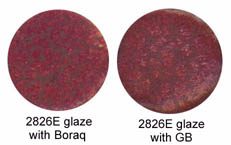
|
To the left: 31% Gerstley Borate. This is a
horizontal surface and the two are applied close to the same thickness. The red crystals lie on a dark glass on both and they
are fairly similar. Click here to see
vertical surfaces that are less similar, the Boraq version being darker because its
crystals are larger and more isolated.
Below is a worst-case example of the 2826E recipe using Boraq 1. It is
applied thinly and only a few red crystals have managed to form. However a
best case example is the Boraq 3.
"The person who submitted this glaze for testing also said that "green
flecks" would sometimes appear with new batches of Cornwall Stone.
|
| G2826E |
GB
Formula |
GB
Mole% |
Boraq 1 |
Boraq 3 |
| CaO |
0.41 * |
8.11 |
6.62 |
8.71 |
| MgO |
0.46 * |
9.10 |
8.43 |
8.29 |
| K2O |
0.03 * |
0.64 |
0.71 |
0.69 |
| Na2O |
0.11 * |
2.10 |
1.76 |
1.63 |
| TiO2 |
0.00
|
0.04
|
0.05 |
0.05 |
|
Al2O3
|
0.17
|
3.39
|
3.67 |
3.61 |
|
B2O3
|
0.41
|
8.16
|
9.68 |
8.61 |
|
SiO2
|
3.14
|
62.59
|
63.19 |
62.55 |
|
Fe2O3
|
0.29
|
5.86
|
5.84 |
5.82 |
|
This chart compares
the mole% formula of the Gerstley Borate version of the glaze with the Boraq
versions (mole% is the formula in percent rather than unity format, it is being
popularized by Richard Eppler).
|
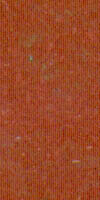
With GB
|
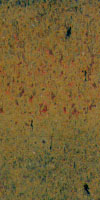
With Boraq 1
|
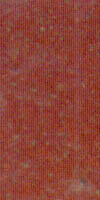
With Boraq 3
|
|
Another demonstration of the benefits of adding dolomite and whiting to the
Boraq 1 recipe for iron reds (making Boraq 2 and 3) are the fired results with G2826D recipe. The original glaze contains more than 50% Gerstley Borate.
The fired samples of the Boraq 2 and GB versions here look more different than the
glazed tiles.
| G2826D | GB Formula | GB Mole% | Boraq
2 | Boraq 3 |
| CaO |
0.51
* |
13.84% |
13.72% |
14.86% |
| MgO |
0.40
* |
10.86 |
10.71 |
9.39 |
| K2O |
0.00
* |
0.10 |
0.19 |
0.19 |
| Na2O |
0.09
* |
2.57 |
1.72 |
1.72 |
| Al2O3 |
0.01
|
0.35 |
0.77 |
0.78 |
| B2O3 |
0.54
|
14.69 |
15.42 |
15.41 |
| SiO2 |
1.79
|
48.91 |
48.83 |
48.98 |
| Fe2O3 |
0.32
|
8.68 |
8.55 |
8.58 |
|
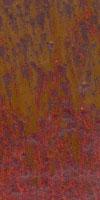
With Boraq 2
|
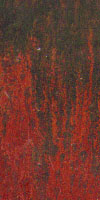
With GB
|
We also did a firing using with GB,
Boraq2, Laguna Borate our extrapolated Laguna Borate. All of them fired almost identical.
The Boraq 3 version gave best results. Small magnified
sections of tiles with an incised line are shown below. As in the above
glaze, the samples look identical.
INSIGHT 5.3 Full Report on Boraq 3 Version
2826D1
2826D Iron Red with GB |
2826D2
2826D Iron Red with Boraq 3 |
|
|

|
|
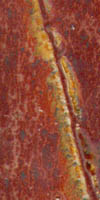
|
At cone 5 iron reds can produce
stunning surfaces, we were amazed at the vibrancy and variegation of the
color, especially on porcelain. However we were also amazed at the amount
they run.
Randy's Red
This is a popular iron red and it employs the standard GB 50, kaolin 20,
silica 30 base recipe and adds 15% iron. Our tests using Boraq 2 show it to fire
very similar. It goes on thicker so you must dip quickly.
Floating Red (Oxblood Red)
Gertley Borate 54.88
Talc 14.63
Silica 30.49
RIO 21.95
This is a dark chocolate brown with streaks of red. With this much GB it is very fluid at cone 6
and tends to bubble if fired too fast between 700 and 900C (1292 to 1692F) or reduced.
What to do about the runny nature of iron reds
Here is a comment from Paul Lewing: "I've tested and used dozens of versions of iron red
glazes ... They are all runny and very sensitive to temperature and even more to rate of cooling, and are very affected by the brand of iron you use. And they won't be red
if the Si/Al ratio is under about 18:1, or if there's more Mg and Ca. Food-safe? maybe. Durable?
no way. I've given up on them in favor of a lead glaze I call Drop Dead Red,
which has all the same post-firing problems but does at least come out consistently iron red and glossy."
Here is a comment from Timoty Joko-Veltman:
I have to strongly disagree with Mr. Lewing on this one. Below are the
unity formulas for two recipes I fire to 1270C (oxidation), and which
seem to me to contradict what Mr. Lewing says.
Kaki #1
0.44 CaO
0.23 MgO
0.23 K2O
0.11 Na2O
0.18 P2O5
0.40 Al2O3
2.98 SiO2
0.20 Fe2O3
7.42 Si:Al Ratio
Kaki #2
0.56 CaO
0.22 MgO
0.15 K2O
0.07 Na2O
0.27 P2O5
0.45 Al2O3
3.88 SiO2
0.23 Fe2O3
8.57 Si:Al Ratio
My personal preference is for the latter of the two, but both are
reliably red, glossy, non-runny, and contain significant amounts of CaO
and MgO.
However there is an answer:
Use a less fluxed and therefore less fluid underbase version of the glaze and a thin application of the fluid overtop.
How? Use INSIGHT to increase the silica/alumina in the iron red glaze while maintaining their ratio, apply this
less melting version in a thick layer, then apply a thin layer of the original glaze.
The result will be the visual character of the thicker version without the
runniness. Of course, this means you need to have two glazes and double dip, but it is worth it for iron reds.
For this to work your glaze cannot have excessive shrinkage during drying or it
will crack and peel after double dip. Here is an interesting parallel: we found that Randy's Red
(15% iron) gives the brighter color associated with a thick layer and yet does not run when applied
in a thin layer over Ravenscrag slip on porcelain
and whiteware bodies.
Consistent Iron Oxide, We Take it for Granted
Here is an interesting note from one reader: "For a long time iron
oxide (as a coloring or pigment) was found in natural deposits. While these
materials worked well in paints they were not chemically as consistent as they
physically appeared. This led commercial ceramics to condemn it as an unwanted
tramp ingredient or contaminant. That was a long time ago and today's
technology in processing iron by companies like Elimetis and Pfizer (before
them) has made some very pure forms available to us. Parmelee, Seger, Binns and
many of the other ceramic pioneers did not have access to consistent supplies of
iron oxides. So, times have changed and company A's brand 9098 is the same in
Portland as it is in London. Iron no longer has to be considered a fugitive
material - it can still vary a lot from source to source, just like clays and
feldspars. But, even though its primary use is still as a pigment, it can also
be chemically consistent as long as we stay with the same reputable manufactures
brand and grade.
By Tony Hansen
Follow me on
                        |  |

















